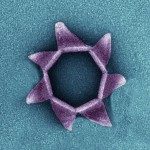Link to Pubmed [PMID] – 8761735
Res. Microbiol. 1996 Mar-Apr;147(3):167-74
The present study sought to determine whether the pigment produced by Proteus mirabilis from the L-forms of various aromatic amino acids under aerobic conditions is melanic in nature. It is a black-brown pigment which behaves like a melanin in many respects, namely solubility features, bleaching by oxidizing agents and positive response to the Fontana-Masson assay. In the present study, for the first time, it was shown by electron spin resonance analysis that a bacterial melanin is able to act as a free radical trap, as was previously demonstrated for other melanins. Scanning electron microscopy studies showed a specific organized structure of the pigment as rounded aggregates of spherical bodies. DNA hybridization data did not reveal, in the P. mirabilis genome, any nucleotide sequence related to Shewanella colwelliana mel A, one of the two melanogenesis systems already defined at the molecular level in bacteria. Results obtained from experiments on pigment production inhibition suggest a possible role of tyrosinase in P. mirabilis melanogenesis. In conclusion, from the bulk of our results, it appears that the pigment produced by P. mirabilis is melanic in nature.

